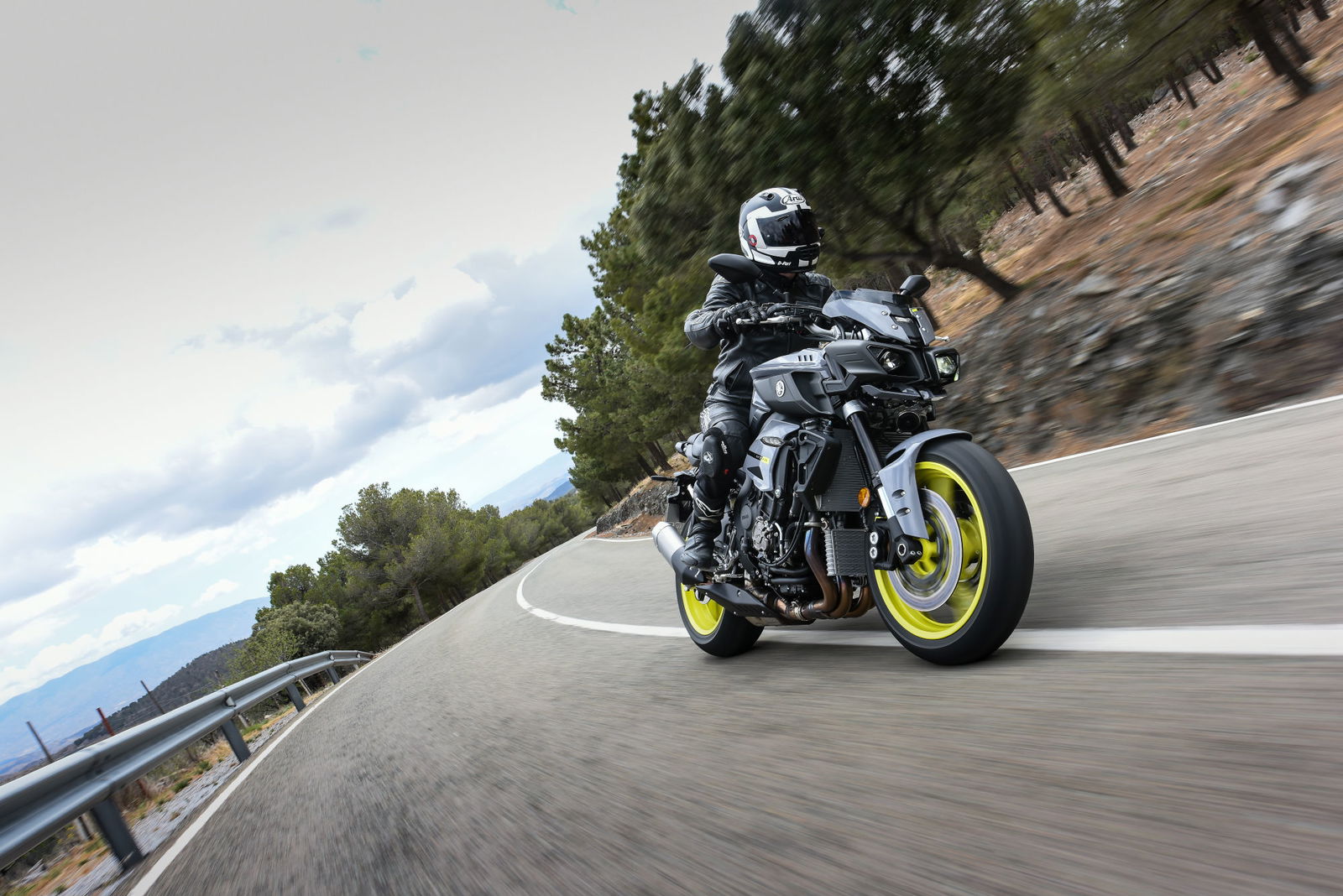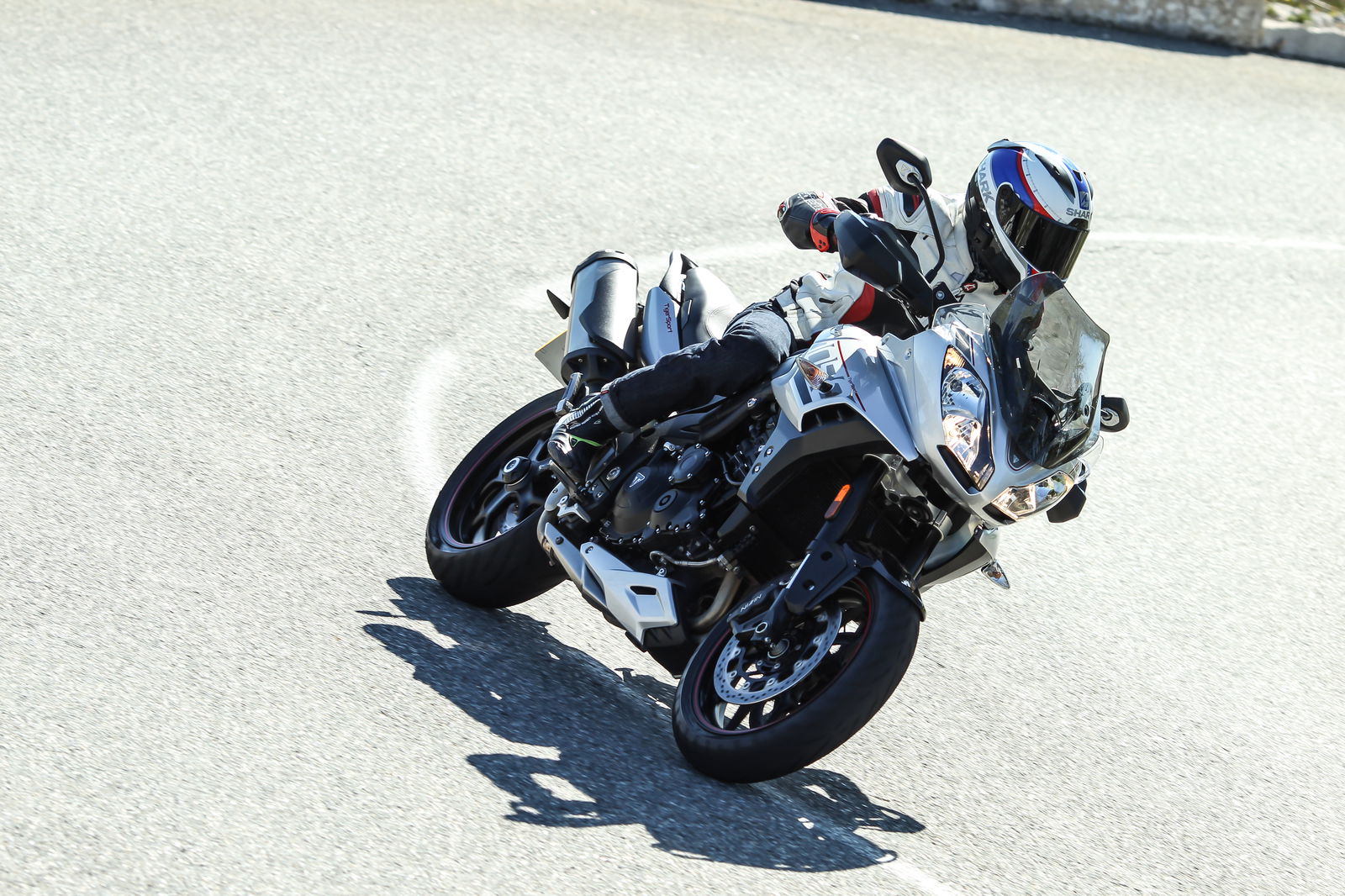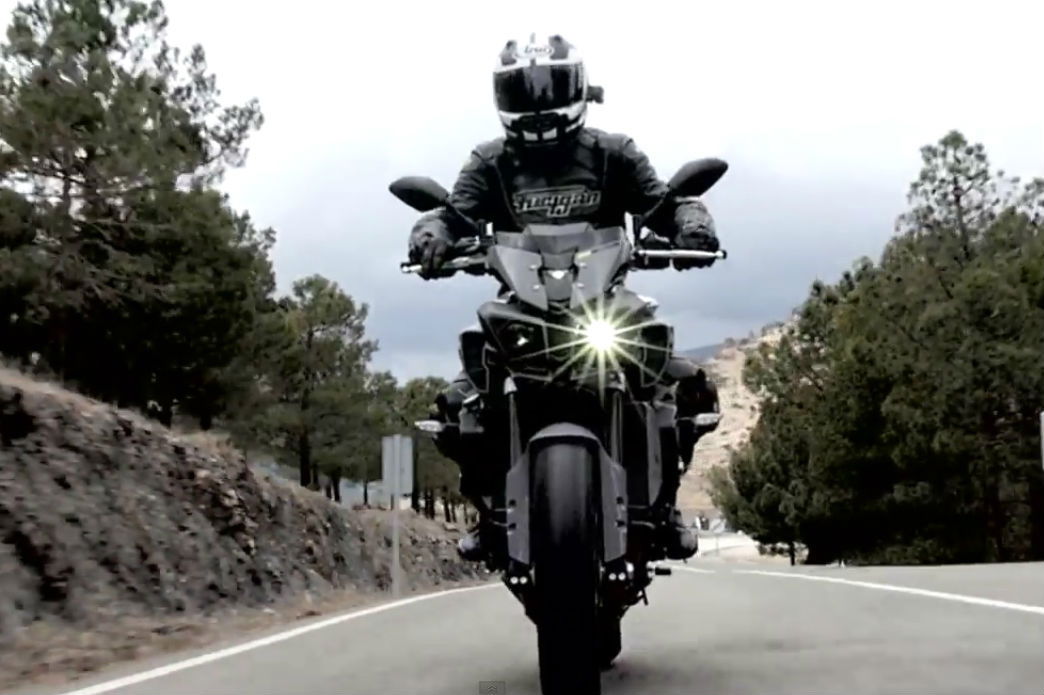First ride: Yamaha MT-10 review
The ultimate super-naked? No. Much better.

IT’S the bike many people have been waiting for. The ultimate Yamaha MT and potentially the ultimate super-naked.
It’s Yamaha’s R1-powered naked bike, with the engine not from a previous generation of the firm’s flagship superbike but the latest, BSB championship-winning one, along with the frame.
So is the MT-10 the ultimate brain-out hyper-naked?
No. It’s much more than that.
Of course it’s unreasonably fast, with a mid-range that might shift tectonic plates. Yamaha hasn’t just put some straight bars on an R1 and left its 200hp engine unaltered. To make it more useful in an un-faired bike, the firm has rained it back to 160hp, the same as the BMW’s S1000R makes, with the reward of a better spread of torque.
The 998cc in-line-four has a new cylinder design, new pistons and a new combustion chamber shape, Yamaha says. The air-box has grown from 10 to 12 litres and the exhaust pipes have changed from titanium to steel.
The crank inertial mass has risen by 40% because it doesn’t need to rev as high, with a red line at 12,000rpm instead of 14,000.
In fact, 40% of the engine parts have been changed according to Yamaha (leaving me wondering when it stops being an R1 engine) to give the MT-10 stronger low-to-mid-range torque, with a peak of 81.9lbft.
With that knowledge, it’s perhaps not quite the animal I might have expected low-down in the range, at about, say, 4,000rpm. But a moment later it’s gone rabid, with the front very eager to take off at about 7,000rpm in second.
All the gears are shorter than the R1’s thanks to a rear sprocket which has 43 teeth instead of 41. Along with the lower red line, that means a top speed in first of about 70mph, compared to about 100mph on the R1. It’s a more useful gearing ratio for the road.
There’s perhaps a bit of a contrast between the sound of the cross-plane crank engine and the way it feels. The noise has a rough edge. When I posted a sample of it on our Facebook page, somebody said it sounded like a ‘couple of wasps in a tin can’. That’s probably partly down to their laptop speakers. I think the roughness of the sound lends the engine character – but there is a tinny quality to it.
It doesn’t match the smooth feel of the power delivery. It’s good that it’s not a monster in the bottom-half of the range, because it makes it more manageable, and the torque higher up the range easier to access. As on the R1 itself, it’s a subtle introduction to a power-house. For all its new parts and stronger mid-range, the revy spirit of the R1 is alive in there.
At 10,000rpm a white flight flashes on the dash telling you to change up. Considering the level of power there, it seems easy to keep the engine close to that white light with gear shifts. It's easy to ride fast, without brutal low-down grunt making you feel you can barely open the throttle, à la Ducati Monster 1200. A slipper-clutch helps keep the bike settled on downshifts by reducing back-torque.
You could probably spend a year riding the R1 and still be getting to know how to make the most of its electronics, with its inertial measurement unit, slide control and maze of menus in the full-colour dash.
That’s been vastly simplified on the MT-10, to traction control and three riding modes, which are very easy to navigate on the non-colour digital dash. There’s obviously a place for sophisticated electronics, but it always seems a relief to get on a machine without them, that lets you focus on riding it instead of programming it.
The riding modes are ‘A’, ‘B’ and ‘Standard’. As usual, each offers a different level of torque in response to a given throttle input. Where ‘Standard’ mode is commonly the one in the middle, on this it’s the softest of the three, and ‘B’ the most aggressive.
I decided the best way to get the measure of a wild animal was probably not by immediately opening the cage door, and so left the MT-10 in ‘Standard’ mode for the first couple of hours of the launch ride, in southern Spain. It makes for a very smooth and manageable initial torque delivery. You could almost forget you were riding a naked R1 – until you open the throttle a few more degrees.
After a bit of time to acclimatise and relax on the bike, I bypassed ‘A’ and went straight for ‘B’ mode, the most aggressive. The difference is dramatic, with a much punchier response to the first throttle input. Going back to ‘Standard’, it now felt a little too laid back - but I’m not sure whether it actually makes any difference to pace. The difference only lies in the first few degrees of throttle twist. After that all modes release full torque and power, so ‘Standard’ effectively just provides a bit more throttle play. If anything, it might have made me smoother in corners, and faster. It’s just a matter of how much you want in one bite.
A button on the right bar changes mode, as long as the throttle is closed. Unusually, when you turn the ignition off, it comes back on in the same mode you left it in, instead of reverting to the safest, like some kind of 160hp nanny.
A button on the left bar changes the level of traction control intervention from one to three, or switches it off altogether. Again, you can change levels on the move with the throttle closed, but you have to stop to switch the TC off.
As with the engine, Yamaha has made a few adaptations to the R1 chassis for its new assignment. Sixty per cent of chassis parts have been altered according to the firm, including the yokes and steel sub-frame. The rider has been moved forward to put 51% of the weight on the front wheel.
The heavier crank and steel pipes bring down the centre-of-gravity.
The most important bit – the aluminium Deltabox main frame – is unchanged, and possibly the best of the machine’s many assets. It’s also got the R1’s swing-arm and fully-adjustable KYB front and rear suspension, with settings tweaked.
One of the things to strike me about the R1, when I first saw one close-up, was how small it is. The MT-10 looks compact for a 1000cc machine too – and feels even smaller. It turns effortlessly, like a machine weighing much less than its claimed 210kg with a full tank.
Turn after turn after turn, on a sunny mountain road, the physical work seemed light. The wide bars make for easy counter-steering, helping to chuck the bike quickly into a lean.

The bars are within easy reach and the pegs straight below the seat. It’s not quite as streetfighter-like as a Z1000 but not far off, so you feel very much over the front wheel, looking straight down the forks, and in touch with the Bridgestone Battlax Hypersport S20 at the end. It’s conducive to leaning forward a little to counter hard acceleration forces. When the front goes light, the chassis retains R1-derived unflinching stability.
That Bridgestone Battlax rubber nearly always performed well but there was one moment, during a cornering photo session, when the rear began to let go, moving sideways a little. It was warm and dry.
The riding position is natural and comfortable. At 200 miles, the launch ride was a good length, but I was ready for more.
This is what really stuck out about the MT-10 for me: not its sharp handling or huge torque, but the fact it’s all that and such a useable motorcycle.
In the pre-ride presentation, a Yamaha man had pointed to the little cowl above the headlight and said it provided ‘effective weather protection’. Like a plaster on a broken leg, I thought.
Fifteen minutes into the ride I accepted I’d been wrong. Usually, even at legal motorway speeds, I eventually feel like my head is being slowly prized off on a naked bike. Obviously you still get wind in the face on the MT-10, but the neck strain is gone. It’s the difference between being able to sit comfortably on the motorway for hours or not. That’s for a rider of average height, like me. One of the riders on the launch was well over six-foot, and complained the cowl was actually creating a wind vortex centred on his head. Shouldn't be so tall.
As speed climbs, the wind is audibly quietened by lowering your head towards the bars, like tucking behind a screen that isn’t there.
Yamaha said the bike had a ‘hidden, clever, practical side’ and I think that’s nothing less than accurate.
It comes with cruise control, which works in fourth to sixth gears at 30-110mph. See how long your nerve lasts with cruise control set at 110mph. Of course I didn’t do that.
The beefier sub-frame has mountings for a pair of optional zip-closing semi-rigid panniers. They’re part of an accessory range which also includes a taller screen and a more deeply-padded seat. It’s basically everything needed to turn this bike into a sports-tourer, making it effectively two models in one. It’s a bit like what Suzuki did with the GSX-S1000 and GSX-S1000F except better, because they don’t take panniers. It’s what Suzuki should have done.
If something limits two-up touring potential, it’s those pillion foot-pegs. I tried climbing onto the pillion seat to test them for comfort. I think my knees were above my ears. I had to get off immediately and walk the cramp away. A Yamaha man pointed out the touring seat was thicker. Unless it’s a foot thicker, it’s not going to cut it.
The Yamaha man also seemed surprised to hear me say that I didn’t think the brakes were quite cutting edge. At the front are the same four-pot calipers and 320mm discs as found on the R1 but with a few ‘external components’ changed according to Yamaha. The rear caliper is new, on a 220mm disc.
The front has loads of power. Unluckily for the MT-10 I have a very fresh memory of the Triumph Thruxton R’s Brembo monoblocs, which give a more precise sense of how much power is being applied. ‘But that’s got no wait, has it?’ said the Yamaha man. In fact the Thruxton R is probably heavier, with a claimed dry weight of 203kg.
The MT-10’s brakes aren’t flawed. They’re just not the best available. I wonder if the MT-10 customer might prefer to have the best available.
But of course that would cost, and, like all MTs, one of the things that makes this bike such a persuasive proposition is its price – £9,999 plus road tax and first registration fee. Have that, BMW S1000R, with your 'from £10,350'. And Aprilia Tuono V41100 RR, at £13,136. And KTM 1290 Super Duke R, at £13,999. Fourteen grand? Are you actually nuts?
Go for all the MT-10’s touring accessories and you’re looking at quite a bit more. The pannier set is £495 including fixings and the tall screen £140. If you want heated grips, that’s another £120, and the touring seat is £220.
There’s also a quick-shifter, at £199.99, and I’d definitely be having the radiator and oil cooler guard, at £79,99 and £64,99 respectively. One of the bikes on the launch ride took a hit to the unprotected radiator and dumped its coolant. This isn’t so much a criticism of the MT-10 as one of the market: why do so many bikes leave the production line without radiator protection? There are stones out there. Lots of them. The damaged MT-10 radiator looked like it had been shot with a sawn-off.
The MT-10’s closest competitor seems to be the S1000R and I can’t wait to see which wins a back-to-back test.
The Yamaha’s styling is a bit divisive, but you’ll already have decided which side of that fence you're on. I can tell you there’s a bit of plastic around the rear light which I felt very much like snapping off, because it’s so bendy and seemingly pointless.
If you’re more concerned with excellent handling and a devastating engine, the MT-10 has it. If you want to wheelie everywhere, it will do it, in almost every gear (as braver journalists than me repeatedly demonstrated).
And if you want a really good road bike, an all-rounder, to live with, as a practical motorcycle, it will do that too.
Good luck, S1000R - it’s going to be hard to beat.
WATCH OUR VIDEO REVIEW OF THE YAMAHA MT-10
Model tested: Yamaha MT-10
Price: £9,999 plus tax and registration
Engine: 998cc in-line-four
Power: 160.4hp @11,500rpm
Torque: 81.9lbft @ 9,000rpm
Wet weight, fully fuelled: 210kg
Frame: Aluminium Deltabox
Suspension: KYB shock and 43mm fork, both fully adjustable
Brakes: Four-pot calipers on 320mm front discs, single pot on 220mm rear
Tyres: Bridgestone Battlax Hypersport S20, 120/70-17 front, 190/55-17 rear
Seat height: 825mm
Fuel capacity: 17 litres
Colours: ‘Night Fluo’, ‘Tech Black’, ‘Race Blu’
Available: June 1

